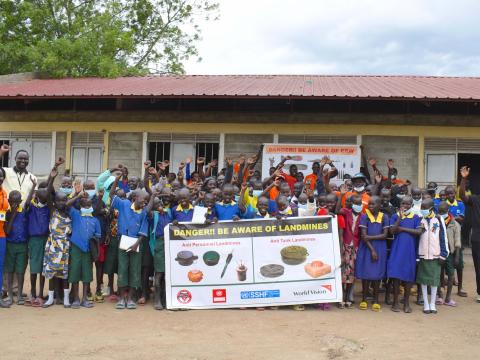Educating and keeping South Sudan’s children and communities safe from unexploded ordnances

World Vision’s Vision Statement “Our vision for every child, life in all its fullness Our prayer for every heart, the will to make it so” are always the guiding inspiration how World Vision implements programs that contribute to the holistic well-being of children.
Providing children with basic needs for health, food, education and water is priority for them to thrive in whatever environment they are in. However, in places that have been affected by armed conflict, apart from the lack of basic needs, other hazards that affect physical safety in the day to day life of a child manifest.

As children grow up, even in areas affected by disasters, it is very valuable for them to be able to play. Play improves the cognitive, physical, social, and emotional well-being of children. Play is one of the main ways in which children learn and develop.
It helps to build self-worth by giving a child a sense of his or her own abilities and to feel good about themselves. Because it's fun, children often become very absorbed in what they are doing and may not be aware of the dangers in their environment.

Children in Mangalla Settlement for the internally displaced located in South Sudan’s capital Juba face various risks during their playtime including the threat of unexploded ordnance (UXO) around the environment where they frequent.
In June 2022, the United Nations Mine Action Service (UNMAS) reported that it has destroyed 1,091,968 UXOs in South Sudan. Among these were 40,121 mines, 76,879 cluster munitions, and 974,968 other items of UXOs.
In June 2022, the United Nations Mine Action Service (UNMAS) reported that it has destroyed 1,091,968 UXOs in South Sudan. Among these were 40,121 mines, 76,879 cluster munitions, and 974,968 other items of UXOs, making facilities like water points and schools safer for the population.
World Vision implements a Mine Risk Awareness Program in Mangalla IDP Settlement. Information, education, and communication (IEC) materials are printed to educate community members about the risk of landmines and how to protect themselves as awareness events and outreach activities were done regularly.

To ensure the inclusion of children, mine awareness education has been conducted in schools through interactive and practical sessions. The children were also encouraged to share at home and their communities through the following:
- Information and education materials helping introduce children to types of explosive devices;
- Visual materials to show potential places where these dangerous devices are likely to be found;
- Building the children’s confidence in identifying explosive devices through Q & A sessions;
- Teaching them on the steps on identification and reporting of suspicions devices.
The trainings and community outreach program so far helped discover and report 14 UXOs in their communities. Indeed, awareness is key in averting and prevention of risks that can put many people’s live in danger, especially the children.

Story by Enid K. Ocaya, HEA and Cash Assistance Manager I Photos by Jemima Tumalu, Communications Officer